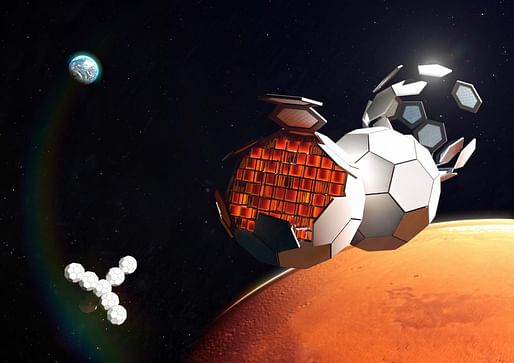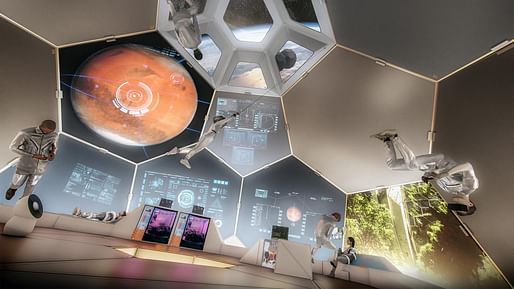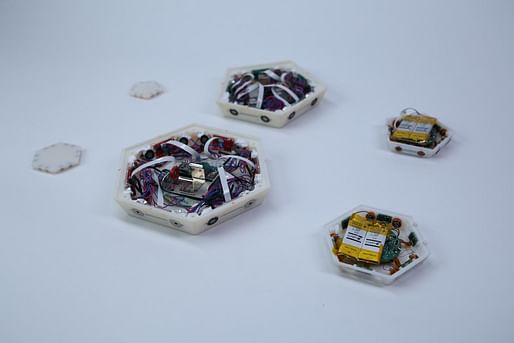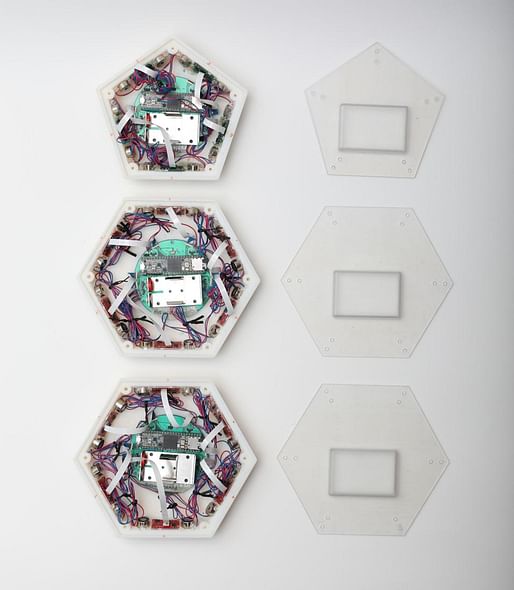

The MIT Media Lab has shared insights into their pioneering project to build habitats in outer space. Named TESSERAE, the project seeks to create a highly-engineered tile which can be used as a building block for self-assembling, adaptive, reconfigurable structures.

Rather than the traditional method of transporting fixed, rigid habitation modules into outer space, creating structures such as the International Space Station, the team behind TESSERAE believes that their modular, self-assembly method can lower payload weight and reduce construction complexity, while also broadening the possibilities of what future space architecture may look like.

Each TESSERAE structure will be made from a set of modular tiles, which can autonomously self-assemble into a given geometry. For the TESSERAE prototype, the team has used 20 hexagonal tiles and 12 pentagonal tiles to create a Buckminster Fuller-like dome. Each tile comprises a rigid outer shell, responsive sensing to aid bonding between tiles, magnets to enable bonding, and a system for onboard power harvesting and management. Tiles designed for habitable structures will also include clamping and sealing mechanisms for pressurization.

When fully operational, the team hopes TESSERAE will serve as multi-use, low-cost orbiting modules that supply critical space infrastructure for future zero-gravity habitats, science labs, staging areas for on-surface exploration on other worlds, and more. The team’s immediate goal is for TESSERAE to support missions in low-Earth orbit, the Moon, and Mars, for both orbit and surface uses.

A TESSERAE-enabled mission would see tiles packed flat and condensed for launch, before being released during orbit to self-assemble into a predetermined geometry. Once assembled, the structure could be reconfigured on demand. The structure may also be disassembled entirely to be packed flat again, either to be transported back to Earth, or to land on the Lunar or Martian surface to reassemble. The team also envisions multiple interlocking TESSERAE structures to serve as larger orbiting bases, and to support futuristic plans for space hotels welcoming tourists in low Earth orbit.

While TESSERAE is technically an acronym (standing for Tessellated Electromagnetic Space Structures for the Exploration of Reconfigurable, Adaptive Environments), the name and wider project draw significant influence from Roman mosaics. In ancient Roman history, mosaics were formed of small, standard, interlocking pieces also called tesserae. “We make this reference to ancient history, when designing an artefact of our space exploration future,” said the team, “to tie architectural elements together across scales and across millennia.”

Following the successful deployment of an early TESSERAE prototype on a zero-gravity flight in 2017, and further testing aboard a Blue Origin suborbital launch vehicle in 2019, 2020 saw seven TESSERAE tiles broad about a SpaceX launch to the International Space Station. The tiles were released from the ISS, where they successfully self-assembled.

News of TESSERAE’s development comes weeks after NASA awarded grants to three U.S. universities to develop lunar infrastructure. Last year, it was announced that the world’s first space hotel was to begin construction in 2026, while Blue Origin announced plans to build a mixed-use space station by the end of the decade.
At the end of last year, meanwhile, we spoke with Jakob Lange from BIG, who offered an insight into the firm’s Mars Dune Alpha project, a prototype which is currently under construction at the Johnson Space Center in Houston, Texas.
6 Comments
Am surprised the MIT Media Lab recovered from that fake plant growing scandal and the Epstein connections. Apparently there is still an apatite for Dezeen-depth design 'provocations' and sci-fi gimmicks.
Hush troll.
Habitats for outer space? Ok. Meanwhile back on earth some of us shake our heads in wonder.
Then do something about it other than posting online.
It looks worked out and prototyped beyond the level of most US arch school projects, so that's good.
Also, the design of US space vehicles needs new ideas beyond what the largely brain-dead oligopoly of aerospace contractors come up with.
I wonder about how this 'self assembling' tech could be used for things like temporary shelters and such. The possible uses on earth seem promising.
Block this user
Are you sure you want to block this user and hide all related comments throughout the site?
Archinect
This is your first comment on Archinect. Your comment will be visible once approved.